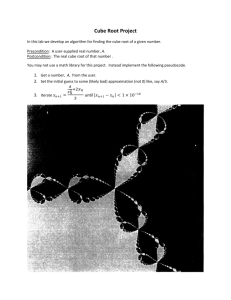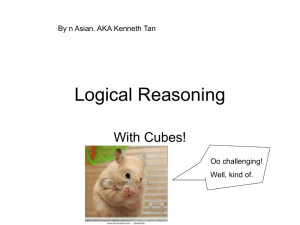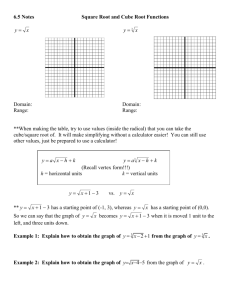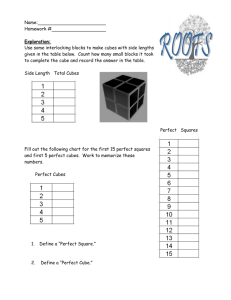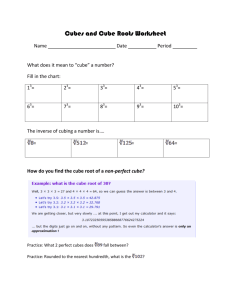NET_CUBE LESSON PLAN
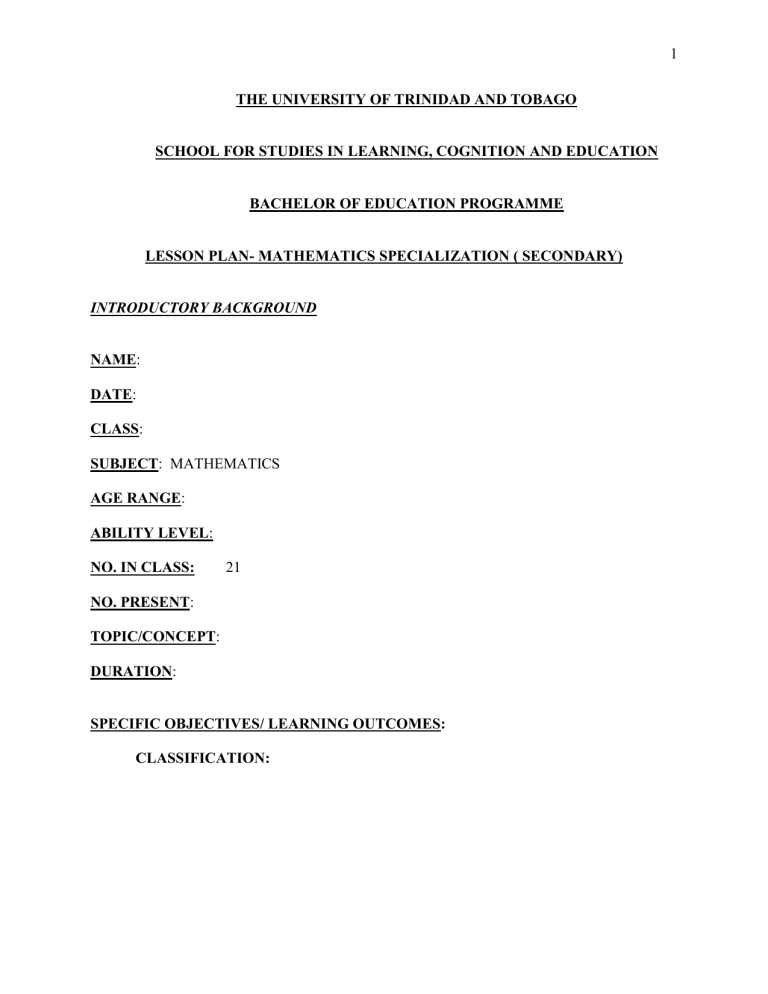
THE UNIVERSITY OF TRINIDAD AND TOBAGO
SCHOOL FOR STUDIES IN LEARNING, COGNITION AND EDUCATION
BACHELOR OF EDUCATION PROGRAMME
LESSON PLAN- MATHEMATICS SPECIALIZATION ( SECONDARY)
INTRODUCTORY BACKGROUND
NAME :
DATE :
CLASS :
SUBJECT : MATHEMATICS
AGE RANGE :
ABILITY LEVEL :
NO. IN CLASS: 21
NO. PRESENT :
TOPIC/CONCEPT :
DURATION :
SPECIFIC OBJECTIVES/ LEARNING OUTCOMES:
CLASSIFICATION:
1
At the end of the lesson students will be able to:
(Cognitive Domain)
1.
Identify items in real life that are shaped like cubes
2.
Identify the attributes/properties of a demonstrated cube
3.
Describe what is the net of a cube
4.
Explain how to derive the net of a given cube
1
2
3
4
5
6
7
Knowledge
Analysis
Knowledge
Comprehension
Synthesis /
Precision
Synthesis /
Precision
Responding
(Cognitive & Psychomotor Domain)
5.
Accurately create more than one distinct net of a cube using concrete cube manipulatives, in a group activity
(Affective Domain)
6.
Participate willingly in a group activity to discover the net of a cube
PREVIOUS KNOWLEDGE, SKILLS AND EXPERIENCES:
1.
Students are able to identify prototypes of the 3 dimensional figures: cubes, cuboids, cylinders, prisms, cones and pyramids.
2.
Students know the properties of a square.
3.
Students are familiar with the following terms related to a cube: face, edge, vertex/vertices
MATHEMATICAL PROCESSES:
1.
The students have to engage in the activity, in a given amount of time, of creating more than one examples of net of a cube. Students cooperate to discover ways to get multiple
2
3 nets. This task involves the problem solving process with the use of concrete manipulative where students engage in visualisation and inventiveness among other skills to find more than one solution to the same problem (more than one net of a cube).
Students have the freedom to use more than one strategy to solve the problem.
2.
The activity to create more than one net of a cube requires the students to recognize structures of the nets which may or may not result in a cube. Students are required to give reason(s) in attempting to distinguish which net gives a cube. This develops their reasoning skills. The group activity encourages students to critique each other’s suggestions in their groups and formulate full-proof methods in proving their answers.
Since each group is required also to explain their solutions reasoning skill is further developed.
3.
The lesson builds on students’ prior knowledge of understanding the nature of 3 dimensional figures and how it makes it possible to derive a net from a cube. By referring to cardboard boxes, which are items in their real life, students will make connections to what they already know and effectively develop their mathematical understanding. The new knowledge of “nets of a cube” is not learnt in isolation and will most likely be imbedded in long term memory.
4.
The use of multiple representations of the cardboard box by demonstration (concrete manipulative) and the diagram of it on the whiteboard provide students with more than one way of deriving the attributes of a cube. Drawing the discovered nets on the checkered grids provided when they are given the 3” X 3” cubes provides them with the opportunity to use representations to record the idea of “nets of a cube”
4
5.
Demonstration of solution(s) in the activity and including the journals in the lesson provides the students with experiences of multiple ways of expressing mathematical understanding. Apart from demonstrating, students communicate their ideas when they write and explain their method(s) used in deriving nets of a cube.
RESOURCES:
1 large cardboard box – (cube-shaped)
25 prepared paper cubes – 3”X3”X3”
Large demonstration cube
Adhesive Tape
6 Pairs of Scissors
White board & White board markers
Prepared Written Assessment
Prepared Activity Worksheets
Laptop
Multimedia Projector
Relevant software
Two dice
A Rubik’s Cube
THE LEARNING ENVIRONMENT:
The desks will be arranged linearly however it should accommodate cooperative learning groups of four or five students. It should also be arranged so that all students are able to see on the
5 whiteboard. The room has proper lighting, good ventilation and an air condition unit. Space is readily available. The environment includes the following resources: 1 large cardboard box –
(cube-shaped), 25 prepared paper cubes – 3”X3”X3”, large demonstration cube, adhesive tape, 6
Pairs of Scissors, white board & white board markers, prepared written assessment, prepared activity worksheets, laptop, multimedia projector, relevant software, two dice and A Rubik’s
Cube.
CLASSROOM
MANAGEMENT STRATEGIES:
ENERGISERS:
THEORETICAL UNDERPINNINGS:
6
SET INDUCTION:
TIME ALLOCATION 1: 3 Minutes
Bring students to the floor. Ask, “Who can say what an attribute is?” Confirm that an attribute describes a quality, property, or characteristic of somebody or something.
Call on a student to stand in front of the class and state an attribute/property of the child (the color of their hair, eyes, shoes, etc.). Ask students, “What are some other attributes (or properties) of … (name of student). Students contribute suggestions.
MAIN IDEAS/ UNDERSTANDINGS/FOCUS
The properties of a cube are: Cubes have twelve edges, eight vertices and six faces which are squares
The net of a 3 dimensional object is
STEP- BY STEP PROCEDURES/ACTIVITIES IN THE LESSON
SECTION ONE – 12 Minutes
Introduce the alternative words to “attributes”: properties, characteristics, qualities.
Ask students, “Who can recall the names of the different three dimensional figures you learnt about in last class?” Pause a few seconds then call on student(s) in class to list them.
Let students know that the main focus of the lesson is on Cubes, their properties, and their nets. Show students Figure 1 on the slide show (see Appendix) which shows various
3D shapes and ask, “Which shape shown is a cube?” Ask a student who raises his/her hand to give an answer.
Reveal to students a large cube- shaped cardboard box to demonstrate an example of where in the real world a cube can be found. Ask students, “What else (in the real world) has the shape of a cube?” List at least Three (3) examples given by students on the whiteboard. If students are unable to give examples, three are
Die (plural Dice)
Ice cubes
Rubik’s Cube
Distribute one cube each to the students and ask them to identify the different properties of the cube, making sure they call the “sides” faces, and “corners” vertices.
Prompt students with the questions, “What can you tell me about
the faces of the cube
the edges of the cube
the vertices of the cube?”
As students identify the properties compile a list on the whiteboard. When all properties are listed allow students to write them in their math notebooks. Ensure the following properties are included:
Cubes have
twelve edges,
eight vertices and
six faces
all faces are squares
To reinforce the properties of a cube show a number of projected images of mixed examples and non-examples of cubes. Students must analyse which are cubes/not cubes, and say why. Pose questions to the entire class then randomly choose students to give responses.
Ask the following questions for each image:
1.
Is this a cube?
2.
Why do you say so?
7
8
SECTION TWO – 20 Minutes
Activity
Place students in groups of three’s for the purpose of the activity.
State the objective of the activity – To Investigating the Net of a Cube
Give students the definition of what is a Net. Then ask students, “Given the definition of a Net, what do you think is the net of a cube?” Write their definition at the top of the
Whiteboard. Allow students to take note of the definition in their notebooks.
Let students know that they will now follow three simple steps in which you start with a cube and derive its net. They will work in their groups of three’s and use ONE cube per group. Use the prepared comprehensive steps shown on the power point slides for students who cannot understand clearly by listening. An instruction sheet is distributed as well for each student.
INSTRUCTIONS:
Step 1.
Place the cube on a flat surface (the desktop/table-top).
Identify the top flat face of the cube.
Using a pair of scissors, cut three edges around the face to make a flap (see Step 1 diagram)
Step 2.
Cut along the four vertical edges downwards until you reach the base of the cube.
Hold the flap and open outwards (see diagram)
Step 3.
The cube can now be opened completely to the form of its net (see diagram)
Demonstrate how the net is formed back into a cube by folding.
Let students know that it is possible to get eleven (11) distinct nets of a cube.
Students in each group now work together to create different nets of a cube, Each group is allowed three cubes. Instructions given:
Students can cut ONLY edges
ALL faces must be joined together by at least one edge each
9
Every student must participate
Groups are given five (5) minutes to create their nets.
Observe students on-task
Presentation of Findings
Students, in their groups, display their nets by sticking them on different sections of the whiteboard. Label each group’s work.
Possible questions to ask group members:
How do you know that you have created a net of a cube?
Was there any special method that you used to arrive at your nets?
Did you make any other observations when you
Can you draw a net of a cube without using the cube?
Is it possible to create a new net of a cube without using the cube? How?
Why do you think we need to learn about Nets?
Confirm that all nets are accurate. Allow students to draw the different nets of a cube that they created, on the Grid Sheet provided.
QUESTIONING STRATEGIES
10
SECTION 1: Teaching
TIME ALLOCATION 2:
CONTENT METHODOLOGY
TEACHING POINTS
An attribute is a property or characteristic of an object
TEACHING STRATEGIES
CLASS DISCUSSION
The teacher asks the students what
(person, thing etc). they think an attribute is. After discussion the class confirms that an attribute describes a quality, property or characteristic of something or someone. The teacher then asks a student to stand at the front of the class and the class then states an attribute of that student.
The teacher now establishes other
Other synonyms for “attribute” are quality, characteristic, trait, feature aspect and element.
Cubes found in the real world are :
Television
Dice
Blocks
Ice block synonyms for “attributes” and lets students know that the main focus of the lesson is on Cubes, their
“attributes”, and their nets.
DEMONSTRATION
The teacher will reveal to students a large cube- shaped cardboard box to demonstrate an example of where in the real world a cube can be found. At least three examples of cubes found in the real world, given by students, will be displayed on the whiteboard.
LEARNING ACTIVITIES
Students contribute suggestions of what they think an attribute is.
Students give examples of cubes found in the real world.
11
The properties of a cube
It is a three – dimensional solid
It bounded by six square faces, twelve edges, with three meeting at each vertex.
It has eight vertices
It has eleven nets
USE OF MANIPULATIVES
Distribute one cube each to the students and ask them to identify the different properties of the cube, making sure they call the “sides” faces, and “corners” vertices.
A list of the properties will be complied on the whiteboard. When all properties are listed, students will be allowed to write them in their math notebooks.
USE OF VISUALS
Show students on the slide show, various 3D shapes consisting of examples and non- examples of cubes. Pose questions to the entire class based on the various 3D shapes then randomly choose students to give responses.
QUESTIONING
-“Who can recall the names of the different three dimensional figures you learnt about in last class?”
Students will identify different properties of the cube and write them in their math notebooks.
Students answer questions based on examples and non- examples of cubes.
Students actively participate in formative questioning
-“What are some other attributes (or properties) of … (name of student).
-“What else (in the real world) has the shape of a cube?”
-“What can you tell me about the faces of the cube, the edges of the cube, the vertices of the cube?”
-Is this a cube?
-Why do you say so?
12
13
SECTIONAL REVIEW 1/ VERIFICATION OF LEARNING DURING THE LESSON 1:
SECTION 2: Activity
TIME ALLOCATION 3:
CONTENT METHODOLOGY
TEACHING POINTS TEACHING STRATEGIES LEARNING
ACTIVITIES
Allow students to take
A net is a two- dimensional figure that can be cut out and folded up to make a three- dimensional solid.
COOPERATIVE LEARNING
Students will be placed in groups of four or five
Teachers will give students the definition of a net and then ask them what they think the net of the cube is. Their definition will be written on the whiteboard. Teacher will let students know that they will now follow three simple steps to derive the net of a cube. They will work in their groups and use ONE cube per note of the definition in their notebooks.
Working in cooperative learning groups students will start with a cube and derive its net.
Students, in their group. After deriving one net, they will try to derive other nets of the cube. Each group is allowed three cubes.
Teacher will demonstrate how the net is formed back into a cube by folding.
They will also observe students on-task and confirm that all nets are accurate. groups, display their nets by sticking them on different sections of the whiteboard.
Allow students to draw the different nets of a cube that they created,
14
EXPLANATION
Teacher will use the procedure shown on the power point slides for students who cannot understand clearly by listening. An instruction sheet will also be provided for each student.
QUESTIONING
How do you know that you have created a net of a cube?
Was there any special method that you used to arrive at your nets?
Did you make any other observations when you
Can you draw a net of a cube without using the cube?
Is it possible to create a new net of a cube without using the cube?
How?
Why do you think we need to learn about Nets? on the Grid Sheet provided.
Students accurately follow teacher’s instructions
15
CLOSING ACTIVITIES: - 5 Minutes
SUMMARY &CLOSURE
Pay special attention to the presentation of materials on the whiteboard which serves as a visual representation of the concepts learned. Students can take notes in their journals in a similarly organized fashion.
ASSESSMENT ACTIVITIES:
ADAPTATIONS OF THE LESSON:
TEACHER’S LESSON APPRAISAL/ REFLECTION ON THE LESSON:
CONTINUATION/ FOLLOW –UP:
CO-OPERATING TEACHER’S COMMENTS:
PRACTICUM ADVISOR’S COMMENTS:
16
17
APPENDIX: FOUR COLUMN LESSON PLAN
Overall goal:
Materials needed:
Steps of the Lesson: Expected student
Learning Activities and Key Questions
Reactions or
Responses
Teacher’s Responses Goals and Method(s) to Student
Reactions/ Things to of Evaluation
Remember
Steps of the Lesson: Expected student
Learning Activities Reactions or and Key Questions Responses
18
Teacher’s Responses
Goals and Method(s) to Student of Evaluation
Reactions/ Things to
Remember
Matthew, M.E. et al (2009). Using Lesson Study and Four- Column Lesson Planning with
Pre-service Teachers. Mathematics Teacher 102(7).pp.504-509.
19
